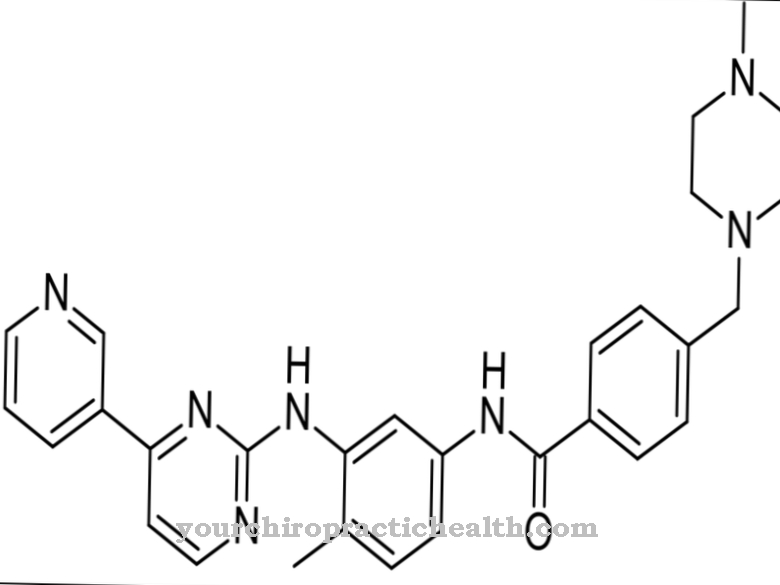Tebipenem is a medicinal substance that belongs to the group of carbapenems. Tebipenem is therefore a so-called beta-lactam antibiotic that is based on penicillin. It is used to fight infectious diseases caused by bacteria.
What is Tebipenem?
Tebipenem is an antibiotic that is given to treat infectious diseases. The chemical formula of the substance (C 22 - H 31 - N 3 - O 6 - S 2) has a beta-lactam ring, which is why tebipenem belongs to the group of beta-lactam antibiotics and has a bactericidal effect.
The moral mass of the white to yellowish white substance is 497.63 g / mol. Due to its chemical and pharmacological properties, tebipenem is also classified as a carbapenem. The closely related active ingredients ertapenem, imipenem, meropenem and doripenem are also part of this group of drugs.
Tebipenem was specifically developed to counter existing antibiotic resistance. Despite positive experience in some clinical studies, the active ingredient is currently only approved in Japan. The active ingredient is therefore not used in any preparations in Europe or the USA. The related active ingredients ertapenem, imipenem, meropenem and doripenem, however, are widespread in the European Union and the USA.
Pharmacological effect
The pharmacological effect of tebipenem largely corresponds to the effect of other carbapenems. The first successes can therefore be recorded quite early on. The active ingredient quickly kills bacteria by inhibiting the cell wall renewal of the bacteria. Bacteria cannot survive without the cell wall, as water can penetrate the interior of the cell and inflate it. The cell then bursts open, causing the bacterium to die.
Tebipenem is - which is typical for representatives of its group of active ingredients - largely insensitive to the bacteria-specific enzyme beta-lactasmase. Bacteria need beta lactasmase to prevent external attack. The enzyme thus largely corresponds to the function of an antibody. Substances sensitive to beta lactasmase are weakened in their effectiveness, as they cannot attack the bacteria without loss. Because of its insensitivity to beta lactasmase, tebipenem is particularly effective.
However, it is necessary to keep a continuously high amount of the active ingredient in the body. A critical amount from which the effectiveness reaches the optimum must always be exceeded (time-dependent killing genetics). Eukaryotic cells that do not have a cell wall are, however, insensitive to tebipenem and other beta-lactam antibiotics. The drug is mainly broken down renally (via the kidneys).
Medical application & use
Tebipenem is given to fight infectious diseases that are caused by infectious bacteria. The drug was specifically developed to treat patients whose symptoms are caused by antibiotic-resistant bacteria as a replacement drug.
From a medical point of view, the field of application is therefore limited compared to other carbapenems, despite their comparatively high effectiveness. It should be used in particular if an infection has been acquired through resistant germs (e.g. in a hospital).
Tebipenem is therefore the active ingredient of first choice only in special exceptional cases. Clinical studies have shown that it is particularly effective in ear infections, so that it is particularly suitable as an alternative to those carbapenems that are mainly prescribed for infections of the ear, nose and throat area (ENT area). In principle, however, due to its pharmacological effect, tebipenem should have the same areas of application as other representatives of the beta-lactam antibiotics.
Furthermore, tebipenem is the first carbapenem whose prodrug form (pivalyl ester) is also suitable for oral use. A prodrug is a pharmacological substance which, taken by itself, is either not very active or completely inactive and only obtains its full effectiveness through metabolism in the body.
Risks & side effects
Tebipenem must not be used if there is a medical contraindication (contraindication). That is u. a. This is the case if an intolerance (allergy) to tebipenem or other representatives of the beta-lactam group (e.g. penicillin) or related carbapenems (e.g. imipenem, meropenem and doripenem) is known.
Even if complications or severe side effects have occurred during previous treatment with carbapenems, Tebipenem should not be used. A contraindication is also given in the case of massive kidney damage, since the breakdown of the active ingredient mainly takes place renally.
The main undesirable side effects that can occur in connection with treatment include fungal infections, a general feeling of weakness and malaise, headache, fatigue, emotional upsets and gastrointestinal complaints. Reactions of the skin are also conceivable, which can manifest as itching, reddening or the development of a rash.
In order to avoid interactions with other medications, the treating physicians should always be informed about all the preparations taken. Otherwise there may be a reduction in effectiveness or an immense increase in side effects, which puts the therapy goals at considerable risk.
























.jpg)



